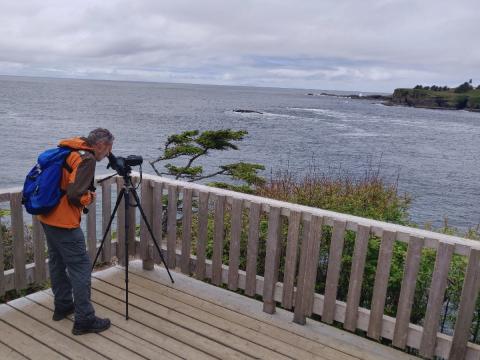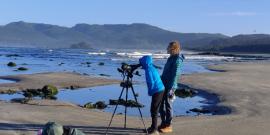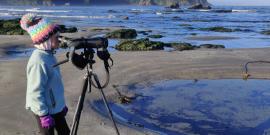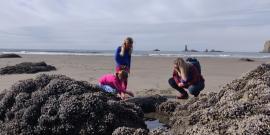

Travel to the End of the Olympic Peninsula to Cape Flattery with Experience Olympic
Neah Bay, Cape Flattery, and Hobuck Beach are exceptional for birding and sightseeing year-round, with hiking and tidepooling as a bonus activities.
A good way to plan a weekday full day (8-10 hour) guided tour to Cape Flattery is to spend the night in or near Port Angeles, drive yourself and your guide from Port Angeles to Cape Flattery, enjoy a private guided wildlife tour, drop your guide in Neah Bay at 4 PM to return to Port Angeles by bus, visit the Makah Museum in Neah Bay that is open until 5 PM, and drive a short distance to your west-end lodging like the Hobuck Beach Resort.
Cape Flattery is as Wild as the Wildlife
Viewing Sea Lions, Sea Otters, Tufted Puffins and other wildlife from Cape Flattery is often difficult to impossible without a wildlife guide, binoculars, and a spotting scope.
The Cape Flattery coastline demonstrates the power of tides and storms through sea caves, sea stacks, and rocky islets. The coastal forest and seascape alone are worth the visit.
The amazing biodiversity found in Neah Bay can be partly attributed to an outstanding position between the Washington Coast and the Strait of Juan de Fuca (Salish Sea).
Neah Bay is a Precious Gem to be Visited Again and Again
Neah Bay is home to the Makah people. Please support the tribe by purchasing a recreational permit, staying at their accommodations (Hobuck Beach Resort), eating in their restaurants (Warmhouse), and learning more about their culture at the Makah Museum (open daily 10-5). Neah Bay does not have fee stations like in Olympic National Park but the Makah recreation pass allows visitors to support Neah Bay's natural attractions like Cape Flattery.
Our tours to Neah Bay and Cape Flattery concentrate on wildlife and leaves the cultural aspects of this special place to be interpreted by the Makah people.
Cape Flattery is Not Any Farther than the Hoh Rainforest
Neah Bay is roughly the same driving time (2 hours one-way) from Port Angeles as the Hoh Rainforest and you have the option of driving past Lake Crescent on 101 to 113 or taking 112 to 113.
Cape Flattery is about a 15 minute drive from Neah Bay, is not in Olympic National Park, and is located on the Makah Reservation.
In additional to Cape Flattery, there are quite a few wildlife viewing spots on the drive to Neah Bay as well as in and around Neah Bay.

The Cape Flattery trail to the Northwestern-most point
After less than a one mile walk on the Cape Flattery trail, enjoy views of Tatoosh Island, sea stacks, sea caves, and a cacophony of currents and wave action. The Gray Whale fluke (tail) photographed was taken on a birding tour to Cape Flattery.
The coastal forest is thick with gnarly Western Hemlock, Sitka Spruce, and Western Red Cedar, banana slugs, and multi-colored fungi, eventually leading to multiple viewing platforms that overlook a dynamic rocky shoreline and Tatoosh Island.
Best drive outside of the park
Once you leave Clallam Bay, the drive to Neah Bay on highway 112 is arguably the best stretch of road for stunning views of Washington’s rocky shoreline, including headlands and rocky outcroppings. The road hugs the Strait of Juan de Fuca and many pullouts lead you down to the both rocky and sandy shorelines.
Bald Eagles will use every appropriately large tree adjacent to the water for nesting in the spring. Pastures provide good spots for potential Roosevelt Elk viewing. This drive should never be rushed as Gray Whales can literally swim right past you.
California and Steller Sea Lions
Unlike seals, which are common throughout the Salish Sea, Sea Lions are more common on the Pacific Ocean. Unlike Seals, Sea Lions can "sit up" and turn their hind flippers forward for walking.
Near Tatoosh Island, there are some protected rocks that almost always have Steller Sea Lions resting or swimming nearby. Steller are larger than California and less common. The fur coats of Steller tend to be overall lighter in color than California. The Sea Lion pictured is a California.
Tufted Puffin's Nest on Tatoosh Island off Cape Flattery
The last platform from the Cape Flattery trail is where we will spend most of our time. This final platform looks out to Tatoosh Island, where Tufted Puffin, Common Murres, and other birds nest over the summer.
The group of seabirds that includes Puffins are called alcids or "penguins of the north". Puffins can actually fly, albeit with some effort. Sometimes we get lucky and can see them naked eye but usually we need optics.
Join us for a Neah Bay overnight vacation tour package centered around viewing species like Tufted Puffin.
Easy to Access Tidepools Near Neah Bay
If the moon and stars align, then we can also go tidepooling in Neah Bay. The rocky shore is quite limited but still worthwhile. The tidepools here are often like moats around rocks and formed by the sand.
In the tidepools, there are shrimp, crabs, fish, and more. The rocks often have barnacles, mussels, anemones, and even a sea star if we are lucky. If you are interested in scheduling a tidepooling tour, you will want to read more about this specific experience.


